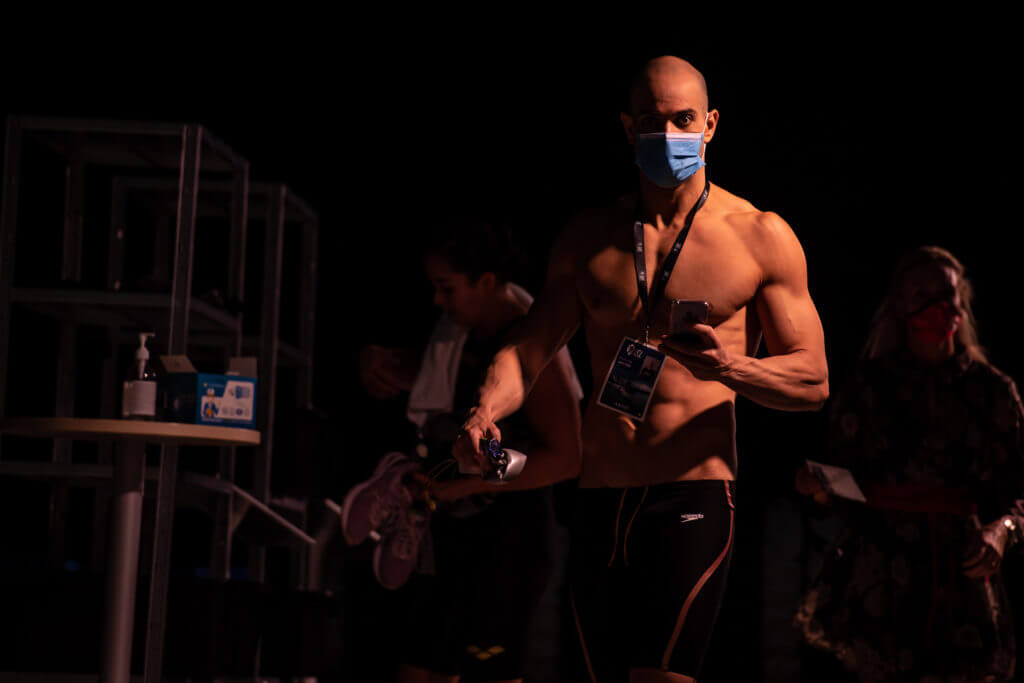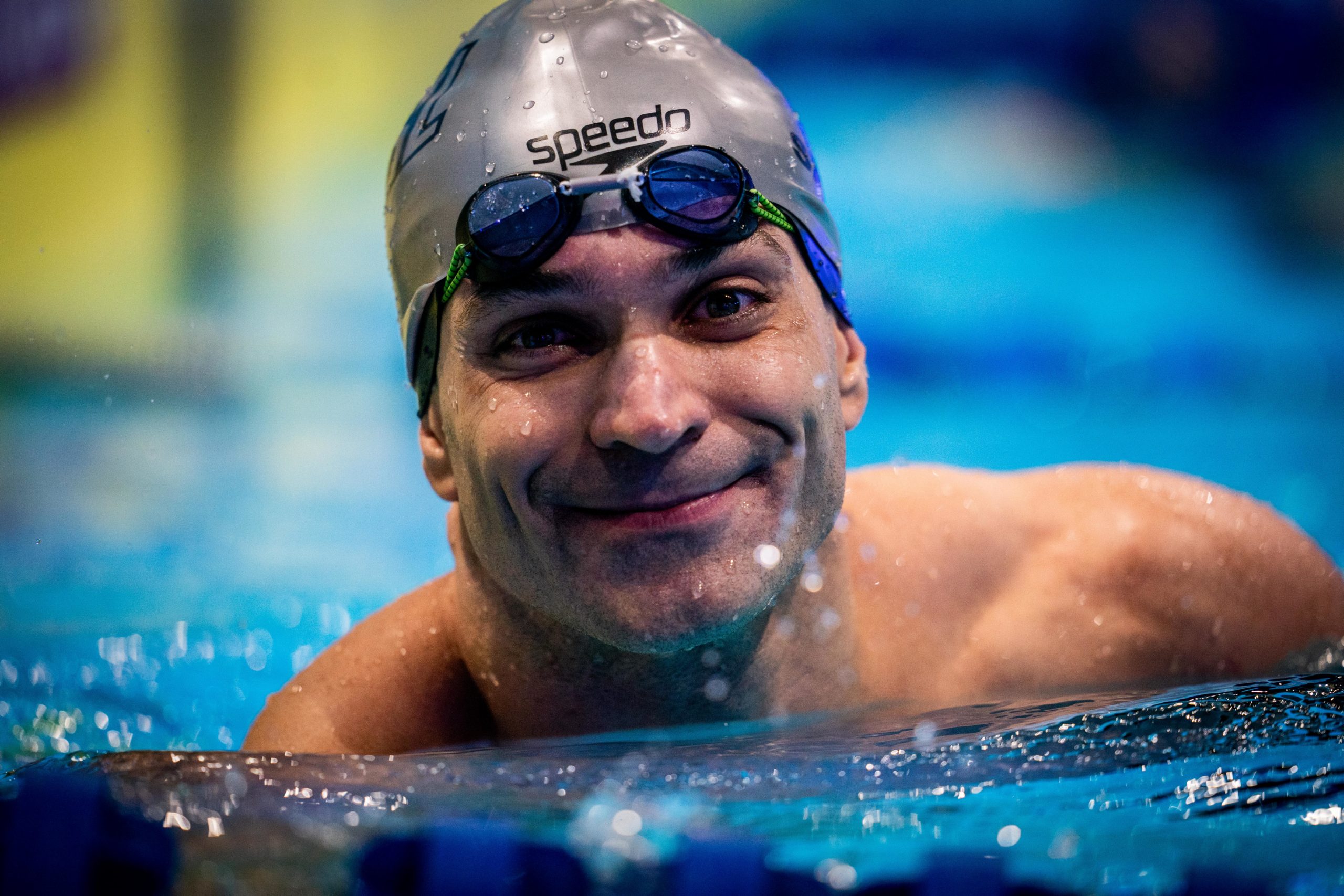How Nicholas Santos, At Age 40, Is Still Sprinting on for Team Iron

Nicholas Santos cracked a smile after he hit the wall first in the 50-meter butterfly during the fourth match of the International Swimming League season.
It wasn’t just because of his win in the event, which took Team Iron into second place to stay in the match, scoring big points over the New York Breakers and DC Trident in the race for a semifinal spot. It wasn’t just because he’d beaten a deep field that included the Cali Condors’ Caeleb Dressel and the Breakers’ duo of Joe Litchfield and Michael Andrew.
It was because, well, Santos is 40 years old and still swimming at such a high level.
“I’m not feeling 100 percent, but we’re just think to get the places, not the special times,” Santos told Swimming World last week. “For me, it’s awesome, especially competing with Caeleb Dressel, he’s a fantastic swimmer here. And I’m still competing at 40 years old, so it’s a challenge for me every day.”
It’s also a challenge for ISL’s young guns to keep up with the Brazilian despite him being about twice their age. Andrew, for instance, was born in 1999 and was a toddler when Santos swam at his first major international meet, the 2001 World Championships. Santos swam fly on Team Iron’s winning medley relay in Match 4, nearly older than the first two swimmers – 23-year-olds Guilherme Basseto and Emre Sakci – combined. (Which set up the skins as breaststroke for Sakci to win.)

Team Iron’s Nicholas Santos; Photo Courtesy: Mine Kasapoglu/ISL
ISL suits Santos’s narrowing specialty. He qualified for the 2008 Olympics in the 50 freestyle, making the semifinals and finishing 16th. With the emergence of Bruno Fratus to complement Cesar Cielo at the 2012 games, the Brazilian sprinters taking fourth and third respectively, Santos lengthened his speed to earn a spot on the 400 free relay in London, a squad that finished a disappointing ninth. He didn’t qualify for the 2016 Games in Rio.
But short-course is his wheelhouse, especially with the prevalence of 50-meter strokes. He won gold at short-course Worlds in 2012 in the 50 fly in 2012 and 2018, among 13 Worlds medals over long- and short-course. He’s medaled at three consecutive long-course Worlds in the 50 fly (two silvers and a bronze). He was still setting records in his late 30s, with a 50 fly SCM world record in 2018 and the South American mark last year. The swim made him the oldest swimmer of recent memory to break a world record.
The 50 fly isn’t an Olympic event, so Santos will have to adjust in the quest for a trip to Tokyo next summer, to either the 100 fly or 50 free, plus the 100 free to try and claim a spot in a crowded relay mix.
It’s not unusual for a Brazilian to be hitting top times at what the swimming world considers an advanced age (fellow Brazilian Marcelo Chierighini is doing just that with Aqua Centurions at age 29). For that, Santos credits his efforts out of the pool: He has a bachelor’s degree in physical therapy and runs what he calls a “strength and conditioning educational company” that handles training and certification for physical therapists and strength coaches. That means he’s surrounded by training methods to keep him performing so well.
“I have a lot contact with strength coaches across the world and try to practice different training methods, so I usually try to put that into my training,” Nicholas Santos said. “I think it’s working for me.”
Santos counts himself fortunate to have never suffered a major injury. He also had access to a 25-meter pool at home to nullify training interruptions during the COVID-19 pandemic. But it’s also about a change in mindset to work smarter rather than harder. Gone are the days of churning out 8,000 meters a day, replaced by shorter, more intense workouts to fine tune his speed.
Whatever happens with Tokyo, Santos is looking forward to the possibility of another ISL season in 2021. He lauds the “business-like environment” of the Budapest bubble, different from his past international experiences. He appreciates not just the opportunity to compete weekly against top swimmers but also to train with them, a reflection of his general collecting of training methods. And, as a businessman, he’s hopeful about what the ISL’s format can mean for the future of the sport’s marketability to new audiences.
“I think it’s another step for world swimming,” Santos said. “Having two hours on TV is different than having prelims, semifinals and finals in other competitions, and everybody says, oh it’s so boring to watch swimming. This is different than comparing with ISL for two hours on tv and you have to recover quickly to swim again. It’s not so predictable for the people.”
And a 40-year-old excelling in the pool is about as unpredictable as results come.
.jpg)
- ISL WEBSITE
- SEASON 2 SCHEDULE
- EUROPEAN ROSTERS
- AMERICAN ROSTERS
- TOKYO & TORONTO NEW ROSTERS
- CBS TV AGREEMENT
- MATCH ONE RESULTS (CONDORS, ENERGY, CURRENT, BREAKERS)
- MATCH TWO RESULTS (ROAR, IRON, TRIDENT, CENTURIONS)
- MATCH THREE RESULTS (CURRENT, FROG KINGS, TITANS, CENTURIONS)
- MATCH FOUR RESULTS (CONDORS, IRON, BREAKERS, TRIDENT)
- MATCH FIVE RESULTS (ROAR, CURRENT, FROG KINGS, TRIDENT)
- MATCH SIX RESULTS (ENERGY, TITANS, BREAKERS, CENTURIONS)
- MATCH SEVEN RESULTS (ENERGY, IRON, TITANS, TRIDENT)
- MATCH EIGHT RESULTS (CONDORS, ROAR, FROG KINGS, BREAKERS)
- MATCH NINE RESULTS (ENERGY, FROG KINGS, IRON, TITANS)
- MATCH TEN RESULTS (CONDORS, CURRENT, ROAR, CENTURIONS)
- SEMI ONE RESULTS
- SEMI TWO RESULTS
- GRAND FINAL RESULTS



